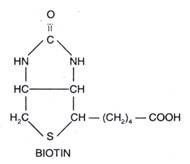The following points highlight the two types of vitamins. The types are: I. Fat Soluble Vitamins and II. Water Soluble Vitamins.
Vitamin Type # I. Fat Soluble Vitamins:
(1) Vitamin A (Axerophthol):
Yellow vegetables, fruits, tomatoes, green leaves of lettuce, cabbage etc., are good plant sources of this vitamin.
Chemical structure of this vitamin which is a highly unsaturated alcohol is given below:
(2) Vitamin D (Calciferol):
Not much is known about this vitamin in plants. Calciferol is the active form of vitamin D and is also known as vitamin D2.
Its chemical structure is given below:
(3) Vitamin E (Tocopherols):
Vegetable fats such as cotton seed oil, wheat germ oil and leafy vegetables are good plant sources of this vitamin. The tocopherols exist in three different forms (α, β and ƴ) and all are derivatives of chromane. α-Tocopherol is biologically most active.
Its structure is as follows:
Exact function of vitamin E is not known but it is thought to be involved in mitochondrial electron transport.
(4) Vitamin K (Phylloquinones):
Green vegetables, soybean oil, tomatoes etc., are chief plant sources of this vitamin. This vitamin exists in two different forms in nature which are known as vitamin K1 and vitamin K2.
Their chemical structures are given below:
Vitamin k has been implicated in electron transport and oxidative phosphorylation in the mitochondria. It is also required for the photosynthetic phosphorylation in a variety of plants.
Vitamin Type # II. Water Soluble Vitamins:
(1) Vitamin B-Complex:
Vitamin B-complex consists of 13 different compounds viz., Thiamine, Lipoic acid, Riboflavin. Niacin. Vitamin B6 (Pyridoxine), Pantothenic acid, Biotin, Inositol, Choline, p-Aminobenzoic acid, Folic acid, Vitamin B12 and Carnitine. Out of these following are well known in plants:
(i) Vitamin B1 or F (Thiamine):
Grain products, soybeans, nuts and yeast are rich plant sources of this vitamin. This vitamin is usually found in two forms, a free form called as thiamine and a bound form which is known as thiamine pyrophosphate (or TPP or Cocarboxylase). The latter is the active form of this vitamin. Their chemical structures are given below.
The active form of this vitamin i.e., thiamine pyrophosphate acts as co-enzyme in the oxidative decarboxylation of α-keto acids
(ii) Lipoic Acid (Thioctic acid):
Among plants, yeast is good source of this vitamin.
Its structure is given below:
It acts as a coenzyme in oxidation-reduction reaction and is involved in oxidative decarboxylation of α-keto acids.
(iii) Vitamin B2 or G (Riboflavins):
This vitamin is widely distributed in plants. Soybeans, green vegetables are good sources of this vitamin.
Its structure is as follows:
This vitamin is important constituent of FMN (Flavin Mono Nucleotide) and FAD (Flavin Adenine Dinucleotide) which act as Coenzymes in many cellular oxidation-reduction reactions.
They also constitute the prosthetic group of certain enzymes.
(iv) Vitamin B5 (Niacin or Nicotinic acid):
This vitamin is widely distributed in plants. Cereal grains, yeast, tomatoes, leafy vegetables are rich plant sources of this vitamin. It is found in the form of its amide (nicotinamide) which is important constituent of the coenzymes NAD and NADP.
The structures of nicotinic acid and nicotinamide are given below:
The coenzymes NAD and NADP take part in oxidation reduction reactions which are associated with many dehydrogenases. Through these coenzymes this vitamin plays important biochemical role in synthesis of high energy bonds, pyruvate metabolism, pentose metabolism, lipid metabolism, glycolysis, nitrogen metabolism and photosynthesis.
(v) Vitamin B6 (Pyridoxine):
The rich plant sources of this vitamin are yeast, cereals etc. The active form of this vitamin is pyridoxal phosphate.
The structures of pyridoxine and pyridoxal phosphate are as follows:
Pyridoxal phosphate acts as coenzyme in transmination and amino acid decarboxylation reactions. This vitamin may also be involved in the synthesis of tryptophan and nicotinic acid.
(vi) Vitamin B3 (Pantothenic acid):
Important plant sources of this vitamin are yeast, cereals, sweet potatoes, tomatoes, potatoes etc.
Structure of this vitamin is given below:
Pantothenic acid is an important constituent of coenzyme-A which is involved in transacylation reactions and thus this vitamin plays important biochemical role in carbohydrate and fat metabolism.
(vii) Vitamin H (Biotin):
Among plants this vitamin has been found in yeast, other micro-organisms and in all parts of the higher plants.
Its structure is as follows:
This vitamin is also known as coenzyme R which acts as carrier of CO2 and plays important role in synthesis of fatty acids. Sometimes biotin acts as prosthetic group of the enzyme.
(viii) Choline:
Cereal grains are good plant sources of this vitamin. Its structure is given below:
Important biochemical functions of this vitamin may be to stimulate the production of phospholipids, to produce acetylcholine or to supply labile methyl groups.
(ix) Folic Acid:
Yeast, mushroom, green leaves, grasses are good plant sources of this vitamin.
Its structure is given below:
This vitamin is an integral part of coenzyme F (i.e., terahydrofolic acid) which is involved in the transfer of one-C compounds and thus plays important role in nucleic acid metabolism.
(2) Vitamin C (L-Ascorbic Acid):
Citrus fruits (orange, lemon etc.), grapefruit, berries, melons, tomatoes, green peppers, leafy vegetables are good sources of this vitamin. West Indian cherry is the richest fruit source of this vitamin.
Its structure is given below:
Vitamin C has strong reducing property and is readily oxidised to dehydroascorbic acid. The latter may again be reduced to ascorbic acid by ascorbic acid oxidase, a Cu containing enzyme found only in plants. It has been suggested that this vitamin may function as a catalyst in photosynthetic phosphorylation. It has also been implicated in the transfer of hydrogen from NADPH to oxygen after coupling with oxidation and reduction of glutathione.













